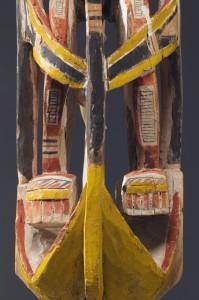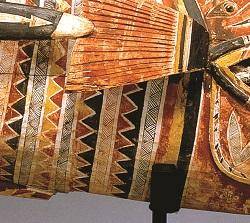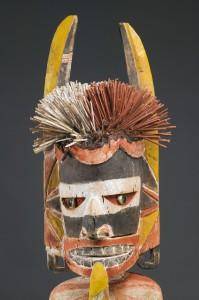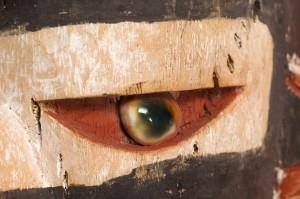Malagan figures
These figures come from New Ireland, a large island that is part of the country of Papua New Guinea. Malagan figures are usually carved by sculptors who live and work in the community. Sculptors use different forms and designs that are specific to each clan. Rights to the designs are owned by individual clan members, multiple different clan members, or the clan as a whole. Designs can only be reproduced by an owner of the rights, with the assistance of a sculptor. Great care is taken to avoid infringing upon the designs owned by another man or lineage. Because Malagan figures are traditionally discarded or burned after use, it is important for the owner to remember exactly what his clan’s Malagan looked like so that he will be able to reproduce the design.
Malagan figures are described as “skins” that contain the life force of a deceased person during a funerary ritual. The name “Malagan” is given to both the carvings and the funeral ceremonies. While the sculpture is not intended to be a picture of the deceased, it is thought of as an image of the life force that produced and animated the once living person. Funerals are considered joyous occasions. Malagan carvings take center stage in funeral rites and allow the soul of the deceased to take part in the spiritual realm of immortality. Although Malagan figures are traditionally discarded after use, ethnographers claim 5,000 to 7,000 Malagan carvings are kept in collections worldwide. Fascinated and intrigued by these sculptures, anthropologists and early colonial collectors began collecting them soon after being discarded. Sometimes, Malagan figures are sold after they have been used for their funerary purposes.
Details

Open Fretwork & Solid Interior
Malagan figures appear to have two forms—the outside and the inside. Open fretwork surrounds a solid, ornately carved and painted central core. The net-like exterior is interpreted as a “trap” for the life force. The figures have been described as “bodies wrapped in images.”

Paint
Painting is the final step in the process of making Malagan figures. The carving is washed in white paint, which is made from ashes and mixed with water from a young coconut. Black, red, and yellow paint is used to create the designs. The act of painting is thought to give the figure life.

Rock Cod
The large figure is a representation of a fish called the rock cod—a wam or bigmaus. The rock cod is known to live under rocks and has the unusual characteristic of becoming female with age. It serves as a symbol of fertility for the clan—with its change in sex it becomes capable of reproducing. The rock cod also connects to the matrilineal structure of the culture.

Warrior Figures with Hornbill Heads
The two smaller figures are defined as warrior figures. Each appears to be topped with a cocomo, or hornbill. The warrior attached to the nose of the fish is called the “stopper warrior,” or Kor. In this instance, the kor is interpreted as containing the life force that has entered the rock cod effigy.

Eyes
The figures’ eyes are made from the iris-like suction pods of shells, which are collected by women on the dry reef. The term for the Malagan eye is “banana shoot.”
More Resources
New Ireland: Art of the South Pacific (Part 1)
New Ireland: Art of the South Pacific (Part 2)
This two part video from the Saint Louis Art Museum explores the life and culture of the indigenous people of New Ireland, Papua New Guinea. Malagan figures and funeral rituals are discussed.
Websites
Malagan Ceremony
The Australian Museum’s website containing a description of the ceremony and examples of objects associated with it.
Books
Fitzpatrick, Judith M. Endangered Peoples of Oceania, Struggles to Survive and Thrive. Greenwood Publishing Group, Inc., 2001.
A portrayal of Oceanic peoples’ struggle to preserve their unique cultural traditions while attempting to become economically independent.
Gillison, David. New Guinea Ceremonies. New York: Harry N. Abrams Publishers, Inc., 2002.
A rare glance into the ceremonies, life and environment of various New Guinea people.
Rainier, Chris. Where Masks Still Dance. Little Brown and Company, Inc., 1996.
A pictorial documentation of different tribes.
Fox, Mary Virginia. Papua New Guinea. Chicago: Children’s Press, 1994.
A children’s book about the land and the people of Papua New Guinea.
Funding for object education resources provided by a grant from the Morgridge Family Foundation. Additional funding provided by the William Randolph Hearst Endowment for Education Programs, and Xcel Energy Foundation. We thank our colleagues at the University of Denver Morgridge College of Education.
The images on this page are intended for classroom use only and may not be reproduced for other reasons without the permission of the Denver Art Museum. This object may not currently be on display at the museum.
